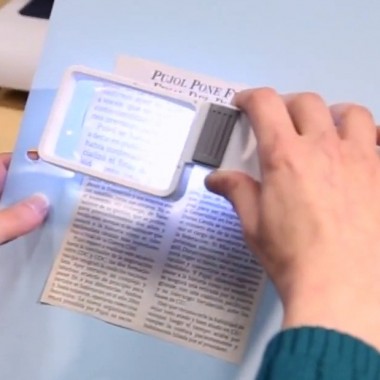
If you don’t have low vision, or know somebody who does, chances are you don’t think about it. But, according to the National Eye Institute, nearly 3 million Americans have low vision, and its prevalence is expected to increase in the US by as much as 70 percent over the next fifteen years.
Dr. Rebecca Marinoff, assistant clinical professor at the SUNY College of Optometry and a member of the University Eye Center’s Vision Rehabilitation Services team, discusses low vision and what can be done to improve the lives of people who have it.
Can you explain what low vision is? How do you know if you have low vision?
A person with low vision has reduced vision that cannot be made completely clear again using regular glasses, contact lenses or cataract surgery. If you have difficulty doing everyday tasks like reading, viewing television, seeing street signs or reading the print on a medicine bottle, you should have an eye exam with your eye doctor and ask if you have low vision.
Can you tell us who typically gets low vision and why?
Low vision can occur because of an inherited eye condition, after an eye injury, because of an age-related eye condition, like macular degeneration or glaucoma, or as a complication of a systemic disease such as diabetes. There are children who are born with low vision or who developed low vision at a young age because of an inherited eye condition. There are adults who had normal vision and then developed an acquired eye condition and their vision became reduced. People are living longer, and that means more people are at risk for age-related eye conditions. These conditions can cause reduced vision.
Whether inherited or acquired, an eye condition that affects a part of the eye (like the cornea, retina or optic nerve) can cause that part of the eye to not work as well as it should and can result in reduced vision.
Watch this to see Dr. Marinoff illustrate various tools used to help people with low vision

What are some of the ways in which you can help people with low vision?
Low vision should not be confused with blindness. Patients with low vision have useful vision which can often be improved with a magnifying device. Low vision rehabilitation services do not cure the cause of the vision problem but instead help to maximize the remaining vision.
In a low vision examination, first we discuss what everyday tasks are difficult for the patient because of his or her vision. This might include reading, seeing the computer, viewing street signs, traveling independently, kitchen-related tasks, money management, medication management or seeing outside when it is very sunny because of the glare.
Then we check the patient’s vision in different ways using eye charts that are designed specifically for those with low vision. We also check side vision, as well as contrast sensitivity (if this is reduced it can cause hazy vision) and we check to see if there are any blind spots in the vision (which can look like dark spots or distortion).
Next we demonstrate different devices that might help the patient do the everyday tasks that are difficult for them to do. This can include high powered reading glasses, magnifiers, telescopes, sunglasses, lamps, electronic devices and computer adaptations. We provide individualized care with an emphasis on visual function.
What about future developments in low vision rehabilitation? What sorts of treatments and options do you anticipate being available down the road?
Technology is developing at a rapid pace and future developments will likely be in this area. Speech output has been added to electronic magnifiers. Today one does not need a separate computer, cell phone, GPS, and camera due to the convergence of technology available through smartphones and tablets. This technology is also available to those who are visually impaired and recently there have been apps developed that help the visually impaired with reading, note taking, sending a text message, travel, as well as identifying colors, money or items, just to name a few. As technology continues to evolve, we will undoubtedly continue to see even more development of applications.

To schedule an appointment call (212) 938-4001 or click here
